Scroll to:
IMPACT OF PREDICTIVE ANALYTICS ON THE ACTIVITIES OF COMPANIES
https://doi.org/10.17747/2078-8886-2018-3-108-113
Abstract
To analyze the impact of predictive analytics on the activities of companies the research was conducted. Subject information: analytics, diagnostics, predicative analytics. The main tools of predictive analytics and solutions in the market of technical solutions are considered. Thanks to the tools of predictive analytics, companies can analyze and predict the processes that occur in time, identify trends, anticipate changes and, for example, plan future more effectively.
For citations:
Khasanov A.R. IMPACT OF PREDICTIVE ANALYTICS ON THE ACTIVITIES OF COMPANIES. Strategic decisions and risk management. 2018;(3):108-113. https://doi.org/10.17747/2078-8886-2018-3-108-113
INTRODUCTION
Intense global competition, uncertainties concerning energy costs and the exponential growth of information technology are pushing the industry to the acquisition of flexible, high-performance and sustainable (energy efficient) production.
In order to cope with the multiple production tasks (for example, issues of flexibility, resource usage, etc.), companies are implementing "smart manufacturing". It is characterized by intensive use of advanced intelligent systems, dynamic response and optimization of the output in real time. Akey factor in the use of "smart manufacturing" is the analysis of big data.
BIG DATA ANALYTICS
The term "big data" refers to information that is stored in the digital storages of companies. Today - this is a resource that organizations use ineffectively, while it can be used to identify trends, patterns, forecasting, to find correlations, etc. The study of data sets in order to find implicit, but useful from the point of view of the company's development information is the basis of business analytics, to which modem companies are turning more and more often, as this may help to reduce costs, increase revenue, improve process efficiency and even to achieve competitiveness.
Traditionally intelligent analytics is quite time consuming. The Fig. 1 shows a typical sequence of actions in predictive analytics.
Fig. 1. The sequence of the work with data in the predictive analytics
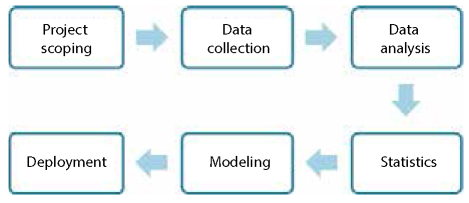
The required data is identified and collected from various sources (e.g., from the resource management system of the company (Enterprise Resource Planning, ERP) or set of tools for managing the clients, sales, management control, automation of business processes (Customer Relationship Management, CRM-systems) or taken from the data stores. Different analytical tools have different requirements on how best to process the data. ETsually it's needed a data conversion to a format supported by a specific analytical system, to ensure that the information could be properly processed. After analyzing the data, conclusions are made on the basis of which the further changes are made, such as the customer segmentation or clustering products.
As far as in global digitization era the companies collect a large amount of diverse information on a regular basis, intelligent big data analysis uses the special software. Over the years it has improved considerably, which led to the fact that modem computers can analyze large amounts of data, respond faster to requests and perform more complex algorithms.
The Fig. 2 shows a diagram with a description of the types of business analytics with an indication of the questions that the extracted and analyzed by the company at each stage of information allows you to answer.
Fig. 2. The types of Big Data Analytics
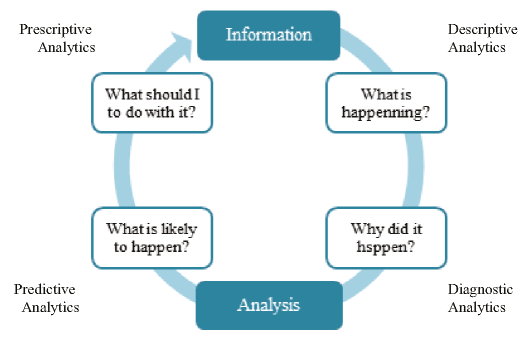
Fig. 3. Types of Predictive Analytics
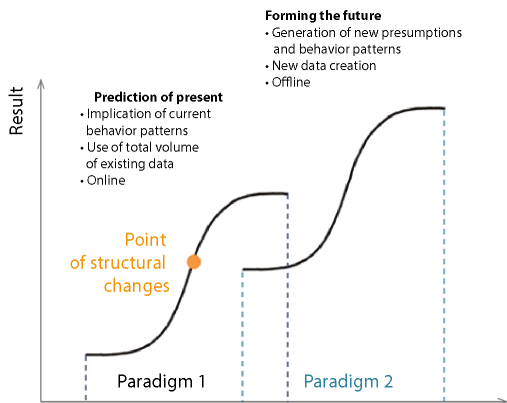
Descriptive Analytics aims to inform about what had happened. Simple reports and visualizations that show what had happened at a certain moment or within a certain period.
Diagnostic Analytics should explain the root causes of the incident. This uses more advanced tools than Descriptive Analytics.
Prescriptive Analytics shows that the company needs to do in order to achieve the desired result. On the market today, there are relatively few solutions of this level, because they need more serious resources of machine learning.
Predictive Analytics is the most popular today. Intelligent analytical tools use advanced algorithms to predict what might happen in the future. Often these tools use artificial intelligence and machine learning technology, involving independent (with no description of detailed sequence of actions made by person) executing computer tasks on finding patterns and solutions based on the proposed data. Interest in Predictive Analytics due to the fact that researchers and companies are concerned to predict the future.
Tabulation 1
The Functionalityof Oracle Data Mining [Buytendijk F., Trepanier L., 2010]
|
Functionality |
Algorithm |
Applicability |
|---|---|---|
|
Classification |
• Logistic regression; • decision trees; • naive Bayesian classifier; • Support Vector Machine |
• Responses simulation; • recommendation "next likely product"; • creating effective strategies to retain workers; • credit default modeling |
|
Regression |
• Multiple regression; • Support Vector Machine |
• Assessing the reputation/debts; • customer profitability modeling |
|
Anomaly detection |
• One-Class Support Vector Model is a module in Azure Machine Learning system to create models for anomaly detection |
• Preventing fraud and network intrusion |
|
The importance of the attribute |
• The minimum length of the description |
• Surgical training; • consumer loyalty index |
|
Association Rules |
• the algorithm for finding Association rules |
• Consumer goods basket analysis; • the analysis of patterns of consumer behavior |
|
Clustering |
• A hierarchical algorithm of K-Means is a clustering algorithm, assuming a pre-specified number of clusters and randomly selected initial centroids; • hierarchical algorithm О-Cluster is the model-based clustering grid |
• Customer segmentation; • the genes and proteins Analysis |
|
functions separation |
• Factorization of nonnegative matrices |
• Text analysis, search |
Predictive Analytics uses a number of statistical tools, data mining and game theory. The Predictive Analytics involves a Efforts (costs) common misconception that the predictions are only associated with the future. However, there is a conceptual classification that solves this problem. According to this classification, there are two types of Predictive Analytics: forecasting the present and forming the future.
The analyzed tools of Predictive Analytics of changes are developing like S-shaped curves. Once the arisen events begin to recur more and more frequently, forming after some time a new trend or a new paradigm that becomes the best practice. At some point something unexpected happens, for example, there is a new technology, a new strong player in the market, economic crisis, etc. The structural changes happen, a new S-curve that characterize the new paradigm appears.
Different types of Analytics are suitable for different predictions (Fig. 3). The forecasting of present is necessary to determine patterns of behavior, identify patterns in the present tense, that is, within the current paradigm. Forming the future, on the contrary, is intended to accumulate new atypical data for the current state of systems in order not only to predict the structural changes, but also to determine the content of the new paradigm.
Thus, the possibilities of the Predictive Analytics technologies are broader than it may seem at first view and allow you not only to make predictions on the basis of the obtained real-time information, but also to collect new data that could have an impact on the current situation in the future. Table. I shows an overview of typical tools based on the functionality of the data analysis.
Fig. 4.The results of a survey of companies regarding the areas of use in their activities of Predictive Analytics [Halper F., 2014]
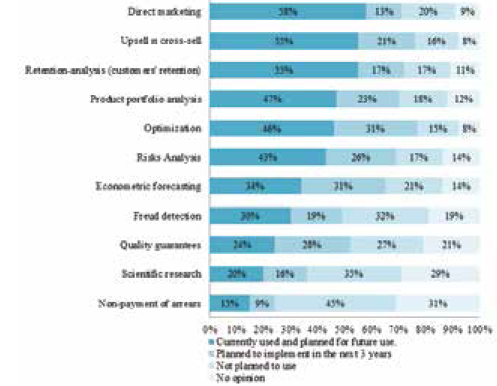
Fig. 5 The benefits of using PredictiveAnaIytics (data from Intel Corporation)
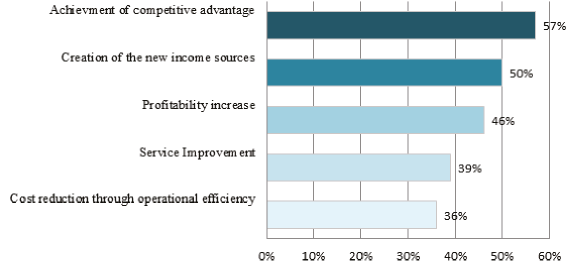
As noted above, the forecasting helps organizations to improve their competitiveness through timely response to changes in the external and internal environment. However, this response always involves taking of certain management decisions, the totality of which forms the control processes aimed at the creation and implementation of new strategies based on the monitoring. Thus, with the Predictive Analytics, obtaining of more accurate and timely data can improve the quality of management processes.
Tabulation 2
Overviewof offerings on the market
|
Product |
Strengths |
Weaknesses |
|---|---|---|
|
SAS Analytics Suite (SAS) |
• Solutions for businesses of all sizes from all industry sectors; • infrastructure and facilities; • integrated solutions; • advanced Analytics; • simple deployment |
• Complexity of the control; • low scores of sets of data mining techniques - SAS Enterprise Miner and S AS VisualAnalytics; • the need to purchase multiple products to ensure full functionality; • the high cost |
|
IBM SPSS Modeler (IBM) |
• A strong customer base and the continuous introduction of innovations; • commitment to technology and open source; • support for a wide range of data types (text analysis, matter analysis, decision management and optimization, etc.; • the model control (accuracy and transparency of work processes, model deployment, degradation monitoring etc.) |
• compatibility issues with other applications; • a high degree of bureaucratization; • weak service |
|
SAP BusinessObjects Predictive Analytics, SAP HANASPS (SAP) |
• Integration with other SAP offerings that provide significant functionality; • the scalability of the system; • the ability to add new components: business analysis system - SAP Business Objects, the tool to control intelligent systems - SAP Predictive Factory, the extensions catalogue - SAP Analytics |
• Unpopularity; • Low customer satisfaction; • Dependence on high-performance NewSQL platform for storing and data processing SAPHANA (High-Performance Analytic Appliance) - high- performance analytic appliance) |
|
KnowledgeSTUDIO (Angoss) |
• Wide range of analytical tasks in a single environment; • intuitive to use software; • ready decision for the specific industries |
• the slow development of the product on the market; • difficulty of processing large amounts of data |
|
Platform Rapid Miner (Rapid Miner) |
• Awide range of application; • ease of use; |
• the restriction of the data use (through specific algorithms); • the absence of a developed global service network |
|
KNIME Analytics Platform (KNIME) |
• Relatively low cost of solutions; • flexibility, openness and extendibility by means of open source; • user access via, system to the data and their transformation; • developed partnership relations |
• the complexity in management; • problems with scaling; • limited capabilities for data visualization; |
|
FICO Decision Management Suite (FICO) |
• Awide range of applications in the financial sphere; • the functionality of the system (product) in key areas of decisionmaking management; • intuitively, intuitively comprehensible model, platform and projects control |
• low level of performance; • the low level of support tools with open source; • limited choice of algorithms |
One of the main predictive tools is the strategic map, which is part of the balanced scorecard. The main task of the latter is to show how the decisions taken in the present may affect the future results. This is done by linking the indicators of front-running or underrun. The first predicts future performance; the second reports on past results.
However, this approach has a drawback: in case of incorrect values of the underrun indicators, the built strategic map will lose its relevance. In addition, the modem realities change very quickly, so past experience is not always applicable to the present.
Obviously, it's needed another approach to data collection in the present to predict the future from the perspective of new assumptions, the questions of "what if?" scenarios. It is in these assumptions we can capture the risk and uncertainly that are part of any strategic planning. To get the relevant forecast, the organization must perform three important steps:
- to make realistic assumptions;
- to highlight the most important assumptions;
- to use the drivers that you can control and to monitor those that cannot be controlled.
USE OF PREDICTIVE ANALYTICS
Companies use Predictive Analytics to solve complex problems and search for new possibilities, from consumer behavior predicting to the equipment maintenance supporting (Fig. 4). Now the Predictive Analytics is used mostly in marketing and sales. Companies want to predict the behavior of the consumer by using a particular marketing campaign, to assess the possibility of using up sales (selling a more expensive item: the customer's motivation to spend more money in your store, for example, to buy a more expensive model of the same product, to add options or services to the purchased product, cross selling: the customer's motivation to spend more money, but now by selling products from other categories than initially were selected by the user), to improve relationship building with clients and keep them. Gradually Predictive Analytics is used in the analysis of products, risk portfolio. It is significant that about 80% of respondents plan to use Predictive Analytics to optimize at least the next three years. Companies are beginning to use Predictive Analytics in operational management, manufacturing, service, etc.
Predictive Analytics is actively used to support major strategic decisions and positive impact on key performance indicators (Fig. 5). It is permissible to use for taking short-term tactical decisions within the framework of operational activities.
Forrester Consulting Agency expects an increase of growth of the market of Predictive Analytics and machine learning at an average of 15% per year to 2021. This is due to the joint use of Predictive Analytics and machine learning with the tools of Industry 4.0 (artificial intelligence, deep learning, Internet of things, etc.). The table. 2 presents comparative characteristics of the main solutions offered in the market.
CONCLUSIONS AND FURTHER RESEARCH DIRECTIONS
Predictive Analytics is one of the ways to process the big data and it allows companies to make more suspended and correct decisions today to achieve the best results tomorrow. Through data analysis, the companies gain valuable information and can build strong relationships with customers, identify new opportunities, anticipate threats, prevent fraud, protecting revenues and reputation. It remains an open question about data saving, information systems security, organized within companies, as well as adequate interpretation of data obtained from different sources. In addition, the question of assessing the economic implications of Predictive Analytics requires a detailed study.
References
1. Abbott D. (2014) Applied predictive analytics: Principles and techniques for the professional data analyst. Indianapolis, IN: John Wiley & Sons. 456 p.
2. Adomavicius G., Tuzhilin A. (2005) Toward the next generation of recommender systems: A survey of the state-of-the-art and possible extensions// IEEE Transactions onKnowledge and Data Engineering. Vol. 17, N 6. P. 734–749.
3. Alstete J. W., Cannarozzi E. G. M. (2014) Big data in managerial decision-making: concerns and concepts to reduce risk. International Journal of Business Continuity and Risk Management. Vol. 5, N 1. P. 57–71.
4. Bag S., Anand N. (2015) Modelling barriers of sustainable supply chain network design using interpretive structural modelling: an insight from food processing sector in India. International Journal of Automation and Logistics. Vol. 1, N 3. P. 234–255.
5. Batra S. (2014) Big Data Analytics and its Reflections on DIKW Hierarchy // Review of Management. Vol. 4, N 1/2. P. 5.
6. Buytendijk F., Trepanier L. (2010) Predictive Analytics: Bringing the tools to the data / Oracle Corporation. Redwood Shores, CA.
7. Halper F. (2014) Predictive analytics for business advantage // TDWI Research. URL: http://tdwi.org/research/2013/12/best-practices-report-predictive-analytics-for-business-advantage.aspx?tc=page0
8. Harford T. (2014) Big data: A big mistake? //Significance. Vol. 11, N 5. P. 14–19.
9. Harris D. (2013) Why Apple, eBay, and Walmart have some of the biggest data warehouses you’ve ever seen // Gigaom.URL: https://gigaom.com/2013/03/27/why-apple-ebay-and-walmart-have-some-of-the-biggest-data-warehouses-youve-ever-seen/.
10. Hashem I. A. T., Yaqoob I., Anuar N. B. et al. (2015) The rise of “big data” on cloud computing: Review and open research issues // Information Systems. Vol. 47. P. 98–115.
11. Jones-Farmer L. A., Ezell J. D., Hazen B. T. (2014) Applying control chart methods to enhance data quality // Technometrics. Vol. 56, N 1. P. 29–41.
12. Kanamoria Y., Matsuokab Y. (2008) Development of a Model for Estimation of Household Consumption and Environmental Load Generation // Refereed Sessions I-II. Monday 10 March. P. 347.
13. Marshall A., Mueck S., Shockley R. (2015). How leading organizations use big data and analytics to innovate // Strategy Leadership. Vol. 43, N 5. P. 32–39.
14. Myers S. A., Sharma A., Gupta P. et al. (2014) Information network or social network? The structure of the twitter follow graph // Proceedings of the 23rd International Conference on World Wide Web. P. 493–498.
15. Nair P. R. (2012) Supply Chain Analytics // CSI Communications. Vol. 33, N 9. P. 11.
16. Tan K. H., Zhan Y., Ji G. et al. (2015) Harvesting big data to enhance supply chain innovation capabilities: An analytic infrastructure based on deduction graph // International Journal of Production Economics. Vol. 165. P. 223–233.
17. The Four V's of Big Data (2016) // IBM Big Data & Analitics Hub. URL: http://www.ibmbigdatahub.com/infographic/four-vs-big-data.
18. Weber G. M., Mandl K. D., Kohane I. S. (2014) Finding the missing link for big biomedical data // Jama. Vol. 311, N 24. P. 2479–2480.
19. Wu X., Zhu X., Wu G.-Q. et al. Data mining with big data // IEEE transactions on knowledge and data engineering. 2014. Vol. 26, N 1. P. 97–107.
20.
About the Author
A. R. KhasanovRussian Federation
Graduate of the first year of study of the Federal State Educational Budgetary Establishment of Higher Education “Financial University at the Government of the Russian Federation”. Research interests: Strategic management, innovations, industry 4.0, industrial Internet of things.
Review
For citations:
Khasanov A.R. IMPACT OF PREDICTIVE ANALYTICS ON THE ACTIVITIES OF COMPANIES. Strategic decisions and risk management. 2018;(3):108-113. https://doi.org/10.17747/2078-8886-2018-3-108-113









































